In the past 18 months we have seen large scale offensives in the Ukraine. The first offensive, by Russian forces against NATO-trained defenders. Now we are seeing the reverse, with an offensive by NATO-trained forces against Russian defenders. What successes, mistakes, and patterns have we seen so far?
A lot of buzzwords get thrown around, but the one I’ll use the most is “combat mindset.” Simply, to be aware of your surroundings and ready to fight. In normal day-to-day life, something like a combat mindset is important too. A person who walks around with his headphones on and not paying attention to his surroundings is easy for criminals to attack and rob. A person who is mindful of what’s going on around him and ready to react if an unexpected emergency happens is safer from criminals (or just getting hit by a car), and is more likely to escape or defend himself effectively in the event he is approached by criminals.
Preparing soldiers, commanders, and their staffs and giving them this elusive combat mindset is easier said than done. Soldiers have a tendency to be bored, not pay attention, and not take their training seriously. In a training scenario, soldiers are supposed to pretend they are in a war zone and act like they are in real danger, but they usually don’t. As a result, when the real thing happens, they still don’t take it seriously and suffer for their carelessness.
Now consider, for example, the American war in Iraq. Iraqis are very different from (most) Americans, culturally, ethnically, religiously, and they don’t speak the same language. Such barriers increase prejudice, which in a war can actually be a good thing because you’ll be more on guard and suspicious toward people who are different than you.
And yet, even in these extreme circumstances, it was still difficult to compel American soldiers to take this environment seriously, and many troops, entire units even, were incredulous that anyone would want to attack them. The most infamous case of this happened on 23 March 2003, when a US Army supply convoy was ambushed and almost totally destroyed, losing 15 out of 18 vehicles. The soldiers and officers had been inadequately trained, most of their heavy weapons did not work, and caused the Army a huge amount of embarrassment.
Instilling American service members with a combat mindset was an ongoing problem, particularly when the Iraqi insurgency started to gain steam. Here’s a sobering video I found recently about the Iraqi insurgency, and their effectiveness against occupying forces:
I find the biggest irony about Iraq to be the prevailing attitude that the USA’s “shock and awe” tactics were effective. In reality, it should be obvious by now that the opposite is true. Saddam’s regime was, by that point, on its last legs. Most people were simply uninterested in fighting for him, and it was easy to bribe and/or intimidate large portions of his army into standing down. Anyone who did fight had wildly outdated weaponry. I find it hard to believe that Saddam’s government wouldn’t have collapsed just as easily had Bush just invaded without the massive levels of devastation. On top of that, there was his inexplicable decision to disband Iraq’s entire government, military, and police forces, leading to hundreds of thousands of unemployed men, and a huge crime wave. That decision alone guaranteed that a good political resolution in Iraq was all but impossible. It also, if nothing else, ensured that any would-be insurgents would have a huge amount of weaponry, as all of Saddam’s unguarded armories were looted. Yes, I did just say that Iraq had outdated weapons, but they were still good enough to arm an insurgency, and they now had a near-unlimited supply of it. It also doesn’t help that the USA imported even more weapons and vehicles for their new puppet state, and managed to lose a lot of those too. The chief arms supplier of America’s enemies is America herself.
Now consider the start of the special military operation in Donbass and Ukraine. While the meme of a “3 day operation” was entirely General Milley’s invention and no Russian leader actually specified a time frame, I think it is true that the SMO was originally intended to be a brief police action. Very little destruction, a near-bloodless fight with the Ukrainian armed forces themselves turning on Zelensky and ousting him from power to save their country from a pointless and devastating war.
It’s difficult to convey the brotherly relationship between Russians and Ukrainians to an American audience, as the USA simply does not have a brotherly nation. If there was a poll, I doubt very many American citizens would say Mexico is a brotherly nation, despite the fact that 11% of our population is Mexican. In a hypothetical military intervention into Mexico, I doubt we would treat them any different than Iraqis. Even in Canada, where the ethnic differences are even narrower than Mexico, I doubt few if any Americans would say Canadians are our brothers.
So, I think it’s fair to say that many or most Russian soldiers, officers, and commanders were incredulous of the idea that Ukrainians would want to attack them. Despite the meme of Russia’s “brutal invasion,” most of the initial footage of the SMO looked like this:
Even up to the present day, Ukrainian soldiers get a lot more fair chances to give up than any Iraqi soldier would:
Now, about this ongoing Ukrainian offensive this week. Consider the infamous “dog pile” of Ukrainian vehicles that went viral, and was then followed up with a new video showing the pile had actually gotten larger with about 6 additional vehicles.
BTW, that last video is from my YouTube channel. Pls subscribe if you haven’t already 🙂
At this point, there shouldn’t be any excuses for not taking the war seriously, or not thinking that the enemy will kill you at the first opportunity. I think what we’re seeing from this offensive can be largely attributed to lack of experience. Also, I think most of the keyboard warriors expressing confusion about how such weird, stupid things could happen just don’t understand what an actual battle is like. Consider these pro-Ukrainian commenters whining on Tom Cooper’s Facebook page, and of course whining from Tom Cooper himself:
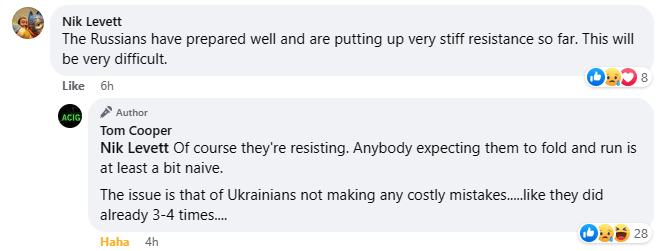
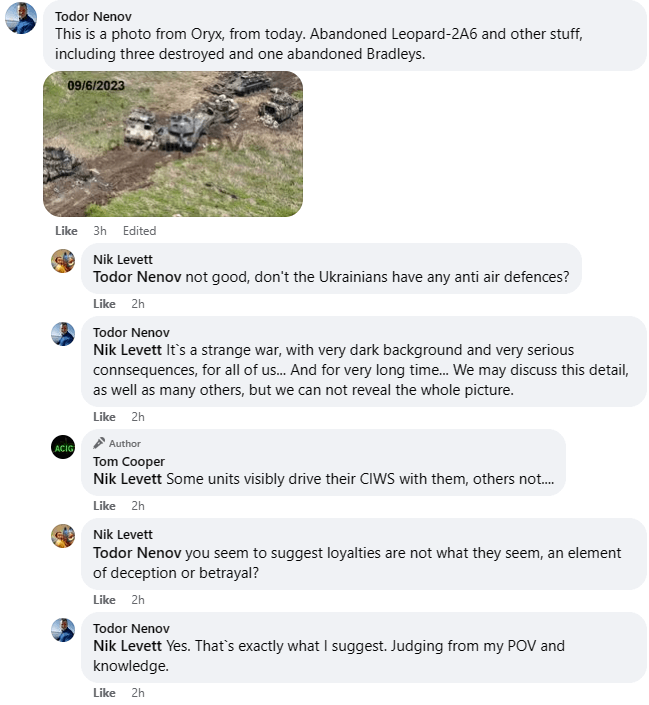
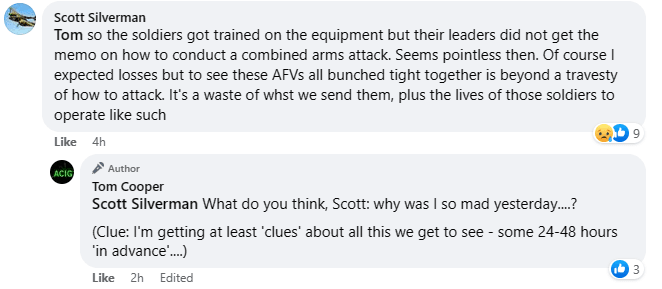
Maintaining proper dispersion between soldiers and vehicles requires a lot of training and practice. And it must be understood that buttoned-up armored vehicles have very little visibility, so it is much harder to be aware of your surroundings than in your personal car while driving down the freeway. Also consider that these Ukrainian attacks started at night. When you start taking enemy fire, especially artillery, it’s natural to want to go to the closest safe place or the closest avenue of escape. Unfortunately, there’s a tendency for everyone to go for the same direction at the same time, and that’s how you get these scenes of bunched up destroyed vehicles that seem to defy common sense.
That said, what’s much less excusable is the military planning (or lack thereof) that went into this. It seems that Ukrainian officers and their NATO advisors expected a repeat of Kharkov, with outnumbered Russians abandoning their overstretched and under-fortified positions. If so, they were badly mistaken.
For people insisting that Ukrainian forces should have used smoke to conceal their movements, well, draw me a picture of where they should have dropped smoke canisters, and how it would have helped them against overhead surveillance.
What has also been totally lacking in these attacks so far is anti-air defenses, and there are multiple (possibly overlapping) reasons for this. The first possible factor is that continuing Russian missile and drone attacks, and Ukraine simply has nothing left to spare, even for their crucial and widely publicized “counter-offensive.” We saw hints of this in the earlier Pentagon leak (see my article about that here if you missed it).
Yet another possible reason is that Russian fire superiority might simply be too strong, and any asset Ukrainians send within artillery and drone range will simply be destroyed. Lancet drones, for example, allegedly have a range of 40 kilometers. That’s far enough to put any supporting Anti-air system at risk.
There are two other fairly brutal factors to consider:
- Where are Ukraine’s veterans from previous battles, and experienced enough to not make such silly mistakes? In reserve? On another front? Dead?
- We also need to consider the possibility that experience with counter-insurgencies in the Middle East is not useful in this war, so the much-anticipated “NATO-trained storm brigades” are inadequately prepared for a real conventional war. There’s more and more evidence to suggest that this is true.
Ian Kummer
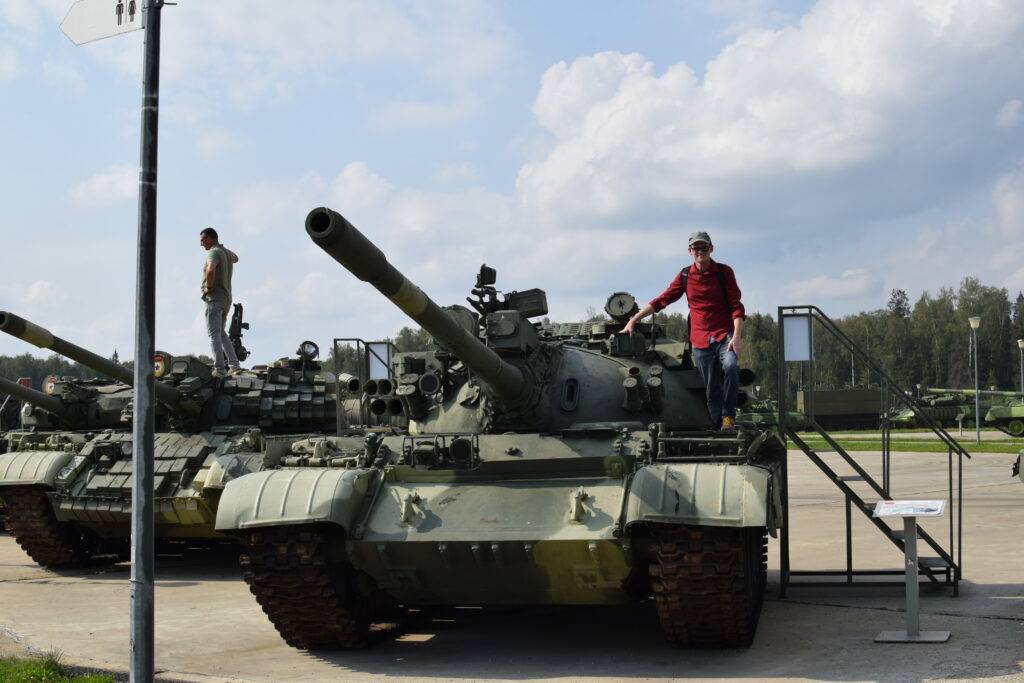
All text in Reading Junkie posts are free to share or republish without permission, and I highly encourage my fellow bloggers to do so. Please be courteous and link back to the original.
I now have a new YouTube channel that I will use to upload videos from my travels around Russia. Expect new content there soon. Please give me a follow here.
Also feel free to connect with me on Quora (I sometimes share unique articles there).

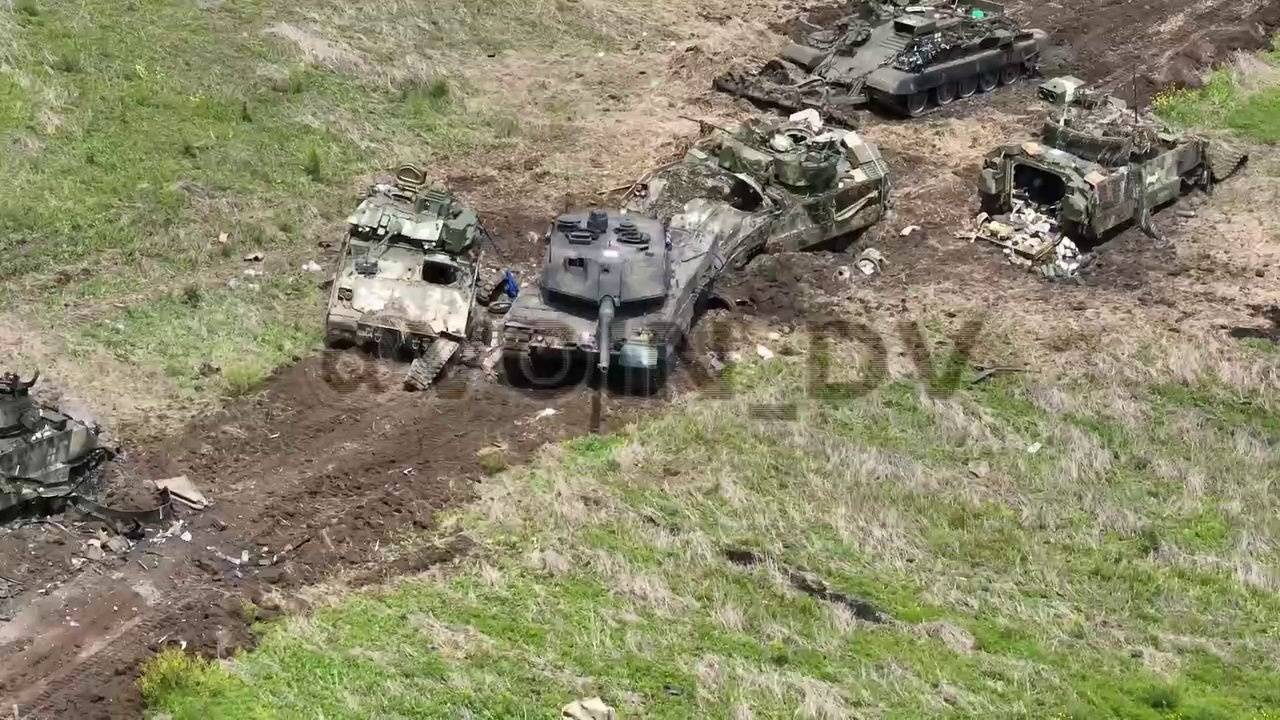

“We also need to consider the possibility that experience with counter-insurgencies in the Middle East is not useful in this war”
This.
“NATO advisors expected a repeat of Kharkov, with outnumbered Russians abandoning their overstretched and under-fortified positions”
I disagree on this one. I think the Russian just went to plan B (or A1) when negotiations broke under Western pressure.
Well, as for Kharkov, Russian strategy has always been: better save the army, if you can. E. g 1812 retreat. Scythian tactics is the word.
As for brotherly nation, yes, let me remind that before 1917 there were only Russians in the census with three subtypes: Russians (великороссы), Ukrainians (малороссы, not украинцы) , Belarusians (белорусы). I guess the equivalent could be: Germans > Bavarian.
The first one mention “Little Bighorn” has lost… but read the excavation of that then burned battlefield a book by A. Fox, and a lot of skilled people with metal detectors, 1986.
When the soldiers in the 7th cavalry, those 200 on the Custer Hill, 1876, lost their tactical deployment, when firing, and horses, they panicking in front of the Indians, the Natives, and began to run, and then “bunched” together, to feel safe, for a while, but the Indians creep forward in the grass, and fired. Perhaps many became suicidal, when thinking of torture, but their Springfield rifles, anyway functioned But this is the psychological reaction to a real danger. They say that´s as the Fetterman fight, 10 years earlier, 1866.
Maybe this struck the Ukrainians with their vehicles, in the same way. Don’t need to be more complicated. The Ukrainian soldiers seem rather old, about 40-50 years, how come ? Even those trained abroad. Are they the first assault line ?
I’ve seen the bunching here explained by the mine clearing technique used. there’s a type of plough fixed to the front of a tracked vehicle which, instead of detonating the mines, just pushes them to the edge of a ploughed path. If you drive down that path, you are “safe”, until someone hits the vehicle in front and you have to either sit there and wait to get hit yourself, or drive off the track, through the ridge where all the mines have been pushed and, if you are “lucky”, into the rest of the mine field.
Bunching up next to already disabled vehicles will allow you to use them as a shield for your own vehicle, so when everything has already gone to shit, it is the least worst option available. It would be interesting to know how many of the crews of those vehicles were able to get out and run for safety precisely because they did bunch up.
I agree that the problem here seems to be in the planning: it looks awfully like NATO really does believe its own BS and planned accordingly.
Good advice, about the panzer-conditions on the battlefield.1876, cavalry horses were the shock tankbrigade, but Custer´s had no sabres, just guns, no Gatling. But the horses can serve as a protection for a while.
A cavalryman must take care of his horse, and 3 others, dismounted, during their deployment on the ground, but the natives use blankets to frightening the horses.
They were as ingenious as the Ukrainians, but that will not help in the long run.
If there’s a Leopard there, which took a hit, maybe the APC:s , tried to protect themselves, behind, running away, if the leading main vehicle was shockingly finished, maybe they tried/ ordered to rescue the Leopard crew, and the others, with some precious experience/education, but the mine clearing mess, explanation is quite enough acceptable.
But there’s in the video 10 vehicles, burning, this wasn’t the first panzer offensive, like something went really wrong, if an army is trained in the Soviet manuals, of successful tank warfare, most experienced in the world, 1945, that must be the Ukrainian´s. A terrible scene, hard to imagine.
A possibly related observation
many videos of abandoned vehicles (standing still, open hatches, presumably immobilized wo/ a track) suggest, that more than a few of the crews of Leopards and Bradleys concluded that once their movement is stopped for whatever reason, they’re safer out of their vehicles than in them.